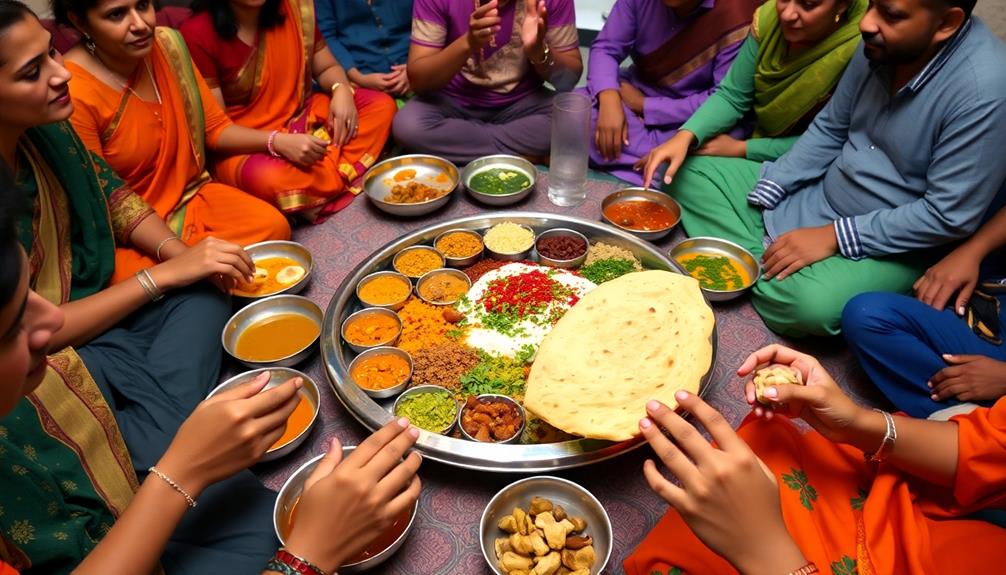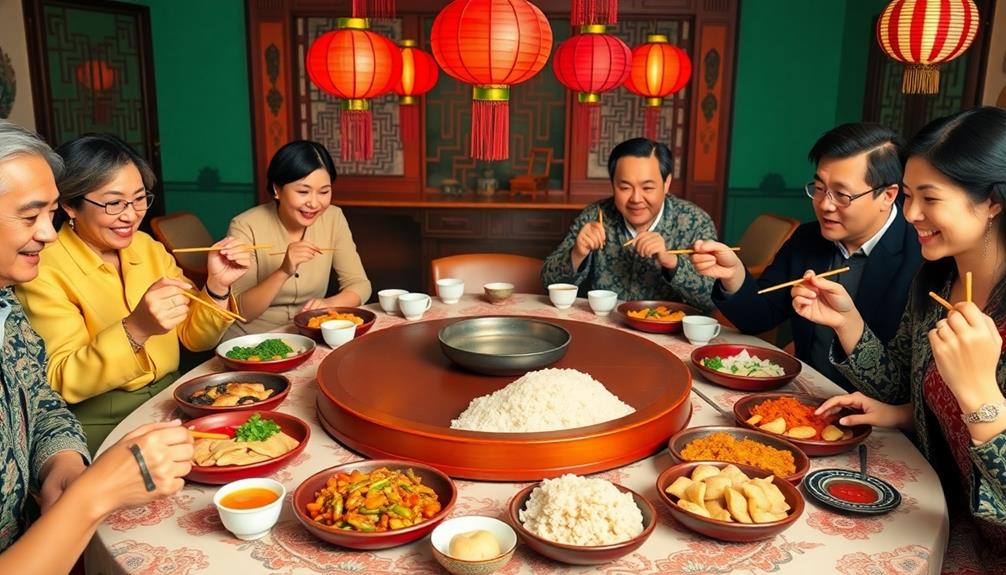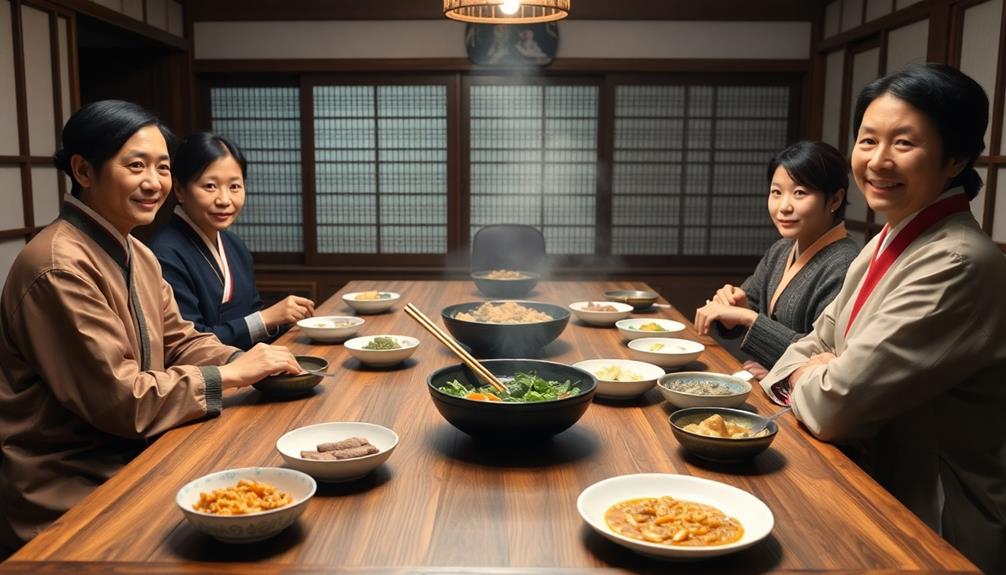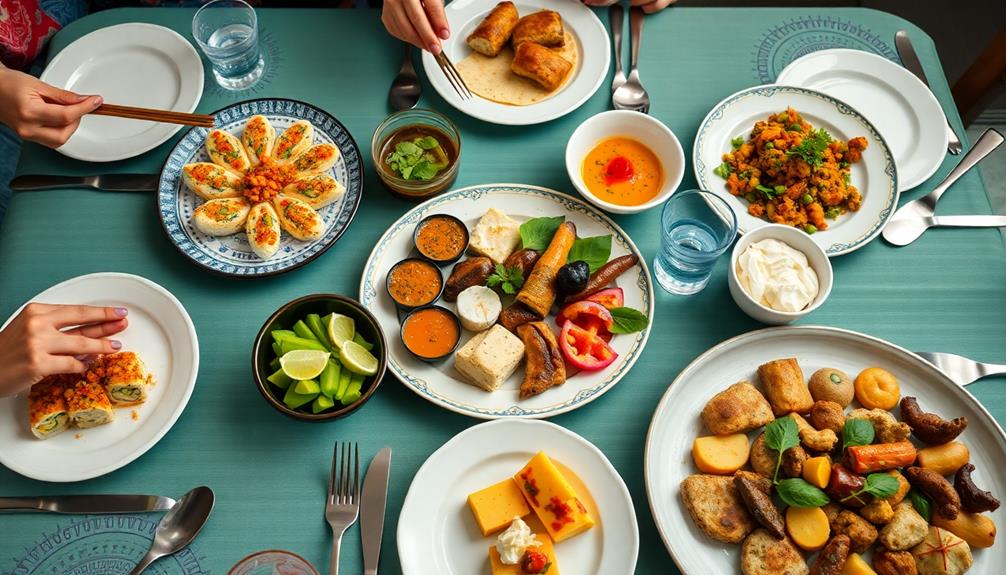Dining etiquette varies widely across cultures, reflecting unique values and traditions. In India and the Middle East, you eat with your right hand, while leaving an empty plate shows satisfaction. In Italy, timing is essential for coffee, with cappuccinos reserved for breakfast. Slurping noodles in Japan is a sign of appreciation, while communal dining emphasizes togetherness in places like China and South Korea. Respecting elders is common everywhere, influencing when you start your meal. Understanding these customs enriches your dining experiences and highlights the importance of cross-cultural awareness. There's so much more to discover about dining etiquette globally.
Key Takeaways
- Eating with the right hand is crucial in India and the Middle East, while communal dining is emphasized in China and Japan.
- Respecting elders by allowing them to start meals first is a common practice in cultures like India, China, and South Korea.
- In Italy, coffee etiquette dictates that cappuccinos are only for breakfast, while espresso is enjoyed post-lunch.
- Slurping noodles in Japan is a sign of appreciation, whereas leaving food on the plate in China indicates satisfaction.
- Understanding and respecting diverse dining customs fosters better social interactions and avoids cultural misunderstandings during meals.
Dining Etiquette in India

When dining in India, you'll quickly notice the importance of using your right hand for eating, as the left is reserved for unclean tasks. This practice is deeply woven into the culture and reflects good etiquette.
Many traditional dishes, such as Mushroom Masala or Chicken Chettinad, are often served in a communal style, encouraging sharing and connection among diners. Before you sit down for a meal, make sure to wash and dry your hands to honor the food and those who prepared it.
As you enjoy the delicious spread, remember that sharing food is a common practice. It's considered respectful to leave an empty plate, signaling your satisfaction with the meal. You'll also want to compliment your host after dining; expressing gratitude for their hospitality and culinary efforts is an essential part of good etiquette.
In traditional settings, patience is key. Wait for the eldest person at the table to stand before you do, as this illustrates respect for elders, a core value in Indian culture.
Coffee Customs in Italy

When you're in Italy, remember that cappuccinos are meant for breakfast, and having one after 11 am might raise some eyebrows.
Italians take their coffee seriously, often enjoying it alongside a light pastry or during a leisurely meal, much like how they savor traditional dishes such as Agnolotti.
After lunch, you'll want to switch to espresso, often sweetened to enhance the experience.
This timing reflects the Italian passion for enjoying coffee at the right moments.
Breakfast Cappuccino Norms
In Italy, enjoying a cappuccino is more than just a morning ritual; it's a reflection of cultural norms that emphasize the importance of timing and tradition.
Italians strictly adhere to the belief that cappuccinos should only be consumed at breakfast, ideally before 11 am. After that, drinking milk-based coffee is considered rude and disruptive to digestion. This emphasis on coffee tradition mirrors the way Horiatiko Psomi (Country Bread) plays an essential role in Greek dining customs, showcasing how different cultures prioritize their culinary practices.
To navigate this Italian coffee culture, keep these good food etiquette tips in mind:
- Stick to Breakfast: Enjoy your cappuccino in the morning and avoid ordering one later in the day.
- Savor the Simplicity: Expect your cappuccino to resemble a flat white, served without a dusting of chocolate. This minimalist approach enhances the coffee's flavor.
- Opt for Espresso After Lunch: If you're craving coffee post-lunch, choose an espresso instead, as it aligns with Italian customs.
Observing these breakfast cappuccino norms not only respects dining etiquette but also enriches your culinary experience in Italy.
Espresso After Lunch
After a satisfying lunch in Italy, you'll find that the best way to conclude your meal is with a shot of espresso. This rich, concentrated coffee not only delights your palate but also aids digestion and gives you a quick energy boost. Keep in mind that the Italian coffee culture emphasizes timing and tradition, so let's explore what to expect.
| Type of Coffee | When to Enjoy |
|---|---|
| Espresso | Anytime after lunch |
| Cappuccino | Before 11 am only |
| Affogato | As a dessert option post-meal |
Italians typically enjoy their espresso straight, without milk or cream, allowing the pure flavors to shine through. If you're feeling adventurous, try an affogato, where a scoop of gelato is "drowned" in hot espresso, creating a delightful dessert experience. Remember, consuming cappuccinos after 11 am is frowned upon, as the heavy milk is believed to disrupt digestion later in the day. Embrace these customs to fully appreciate Italy's deep-rooted love for coffee!
Noodle Etiquette in Japan

Often, slurping noodles in Japan is more than just a quirky habit; it's a way to express enjoyment and appreciation for the meal. In casual dining settings, when you slurp, you're actually complimenting the chef and enhancing your flavor experience.
This practice is especially relevant when enjoying dishes like Hiyashi Chuka (Cold Ramen), which offers a revitalizing taste during the hot summer months. However, be mindful of the atmosphere—formal dining environments may frown upon this practice.
Here are three key points to keep in mind about noodle etiquette in Japan:
- Chopstick Placement: When you're not using your chopsticks, rest them on a holder or the side of your bowl, not directly on the table. This shows respect for the dining space.
- Avoid Upright Chopsticks: Never stick your chopsticks upright in rice, as it resembles funeral offerings and is considered a bad omen.
- Savor Each Bite: Japanese dining culture values respect and tradition. Take the time to appreciate the meal's presentation and flavors, rather than rushing through.
Communal Dining in China

When you experience communal dining in China, you'll find that sharing dishes fosters a warm sense of togetherness.
Popular dishes like Red-Braised Pork Belly and Cumin Lamb are often placed on the table for everyone to enjoy. A lazy Susan often sits at the center of the table, making it easy for everyone to serve themselves.
Remember to respect dining norms, like waiting for the eldest person to start eating before you dig in.
Sharing Dishes Together
Communal dining in China creates a vibrant atmosphere where dishes are shared, promoting connection among diners. This practice mirrors the communal essence found in various cultures, such as Brazil, where diverse dishes like Caldeirada showcase the richness of sharing meals.
In this cultural practice, you'll find that the focus is on equality and togetherness. As you enjoy your meal, remember these key aspects of table manners:
- Use Serving Utensils: Always use serving chopsticks or spoons to take food from communal dishes. This not only shows respect for others but also maintains hygiene.
- Leave Some Food: If you leave a little food on your plate, it's a sign of satisfaction, indicating that you enjoyed the meal and were well-fed.
- Embrace the Experience: Dining together is a cherished social activity, reflecting the values of family, friendship, and community across different cultures.
In communal dining, dishes are placed in the center, allowing everyone to share and bond over food. This practice fosters a sense of togetherness, where every meal is an opportunity to connect.
Lazy Susan Use
The lazy Susan, a rotating serving platform, enhances the dining experience in Chinese culture by making it easy for you to share a variety of dishes with everyone at the table. This communal approach is deeply rooted in tradition, as individual portioning is often seen as selfish.
When you're at a meal, remember to turn the lazy Susan counterclockwise, guaranteeing everyone has equal access to the different dishes. It's considered good etiquette around the table to take a small amount of food at a time, promoting sharing and conversation among diners.
Here's a quick guide to using a lazy Susan:
| Action | What to Do | Why It Matters |
|---|---|---|
| Turn the lazy Susan | Rotate it counterclockwise for others | Guarantees everyone can reach the dishes |
| Use serving utensils | Always use provided utensils for communal dishes | Maintains hygiene and respect |
| Take small portions | Serve yourself a small amount of food | Encourages sharing and conversation |
Respecting Dining Norms
In China, sharing dishes at the table fosters a strong sense of community and connection among diners. This practice is similar to communal dining in other cultures, such as the Ethiopian tradition of sharing dishes like Yetimatim Fitfit that enhances the communal experience.
When you sit down for a meal, you'll notice that everyone shares from communal dishes, often placed on a lazy Susan for easy access. This practice not only promotes togetherness but also enhances the dining experience.
Here are some key norms to keep in mind:
- Wait for the Eldest: Always wait for the eldest person at the table to start eating before you dig in. It shows respect and appreciation for their position.
- Leave a Small Amount: When you finish, leave a small amount of food on your plate. This signals that you're satisfied and that the host provided enough for you, which is considered good etiquette.
- Mind Your Manners: Gentle burping is actually a compliment to the chef, reflecting gratitude for the meal.
Cultural Norms in South Korea

Respecting tradition plays an essential role in South Korean dining etiquette. When you sit down for a meal, be prepared to wait for the eldest person at the table to take the first bite. This shows respect for hierarchy, a significant aspect of South Korean culture.
Meals often feature a variety of dishes, including staples like kimchi, which emphasizes the importance of sharing and enjoying diverse flavors together.
As you pass dishes or pour drinks, always use both hands. This custom demonstrates respect, especially when serving elders. You'll find that sharing food from communal dishes is encouraged, reinforcing the importance of togetherness during meals.
Eating at a pace that matches others at the table is also essential. It reflects your consideration for the group's dining experience, which is valued in South Korea.
Unlike in different countries where individuality may take precedence, here, the collective experience is paramount.
Dining Practices in the Middle East

Dining in the Middle East offers a unique and rich experience shaped by tradition and hospitality. When you're invited to a meal, it's important to respect local customs to truly enjoy the experience.
Middle Eastern cuisine is diverse and flavorful, featuring dishes like Kawarma and desserts such as Harisseh that reflect the region's culinary heritage. Here are three key practices to keep in mind:
- Use Your Right Hand: Always eat with your right hand, as the left is considered unclean. This practice shows respect for the food and those you're dining with.
- Compliment the Host: Be sure to compliment the host on the meal and their hospitality. This reinforces social bonds and acknowledges their effort in preparing the feast.
- Enjoy Communal Dining: Meals are often served family-style, with dishes shared among diners. Embrace the communal aspect, as it emphasizes togetherness and generosity, which are core values in Middle Eastern culture.
Accepting food is a sign of respect, and leaving food on your plate can indicate satisfaction rather than wastefulness.
Importance of Cross-Cultural Awareness

Understanding cross-cultural awareness is essential for anyone looking to explore the diverse landscape of global dining etiquette. When you're aware of different customs, you can prevent misunderstandings and potential offense during international interactions.
For instance, in many Middle Eastern cultures, using your right hand for eating is vital. Knowing this fosters respect for local traditions. Similarly, if you're dining in China, understanding that leaving food on your plate signifies satisfaction can enhance your experience and strengthen your relationships with your hosts.
In Indonesia, being mindful of the importance of communal dishes, such as Nasi Tumpeng, can further enrich your dining experience by celebrating togetherness and gratitude.
Being mindful of norms, like not mixing cheese with seafood in Italy, reflects deeper respect for culinary practices and preferences. Familiarity with diverse dining practices, such as communal sharing in Chinese cuisine or waiting for the eldest to eat first in South Korea, improves social dynamics.
This awareness not only enriches your dining experiences but also promotes mutual respect among diners. By embracing cross-cultural awareness, you open doors to meaningful connections and appreciation for the rich tapestry of global dining etiquette.
Frequently Asked Questions
Why Do Different Cultures Have Different Table Manners?
Different cultures have unique table manners because they're shaped by history, religion, and social norms. These influences reflect what's valued in communal interactions, leading to diverse practices around sharing food, hierarchy, and individual portions.
Why Is Etiquette Associated With Food in Different Cultures Across the World Important?
Did you know 75% of people believe dining etiquette reflects personal character? Understanding food-related customs is important because it fosters respect, strengthens relationships, and enhances communication, making meals enjoyable and meaningful across diverse cultural settings. Observing dining practices allows us to navigate social interactions with sensitivity, especially in environments that bring together individuals from diverse backgrounds. For instance, being aware of different cultures and mourning food traditions can help avoid misunderstandings and demonstrate empathy during somber occasions. Embracing these customs not only enriches our experiences but also builds bridges of understanding and mutual respect.
What Is Etiquette Across Cultures?
Etiquette across cultures encompasses behaviors, manners, and customs that govern social interactions. You'll find that understanding these norms helps you navigate different environments, fostering respect and appreciation for diverse traditions and enhancing your social experiences.
What Is Global Dining Etiquette?
Global dining etiquette involves understanding and respecting various customs. You'll need to learn specific practices, like using utensils in some cultures and eating with hands in others, ensuring you show appreciation and consideration during meals.
Conclusion
Understanding dining etiquette across cultures not only enriches your travel experiences but also fosters deeper connections with others. For instance, imagine sharing a meal in Japan, where you learn the significance of slurping your noodles to express appreciation. By embracing these unique customs, you show respect and gain insight into different ways of life. So, next time you sit down for a meal abroad, pay attention to the local dining etiquette—it might just lead to unforgettable moments!










